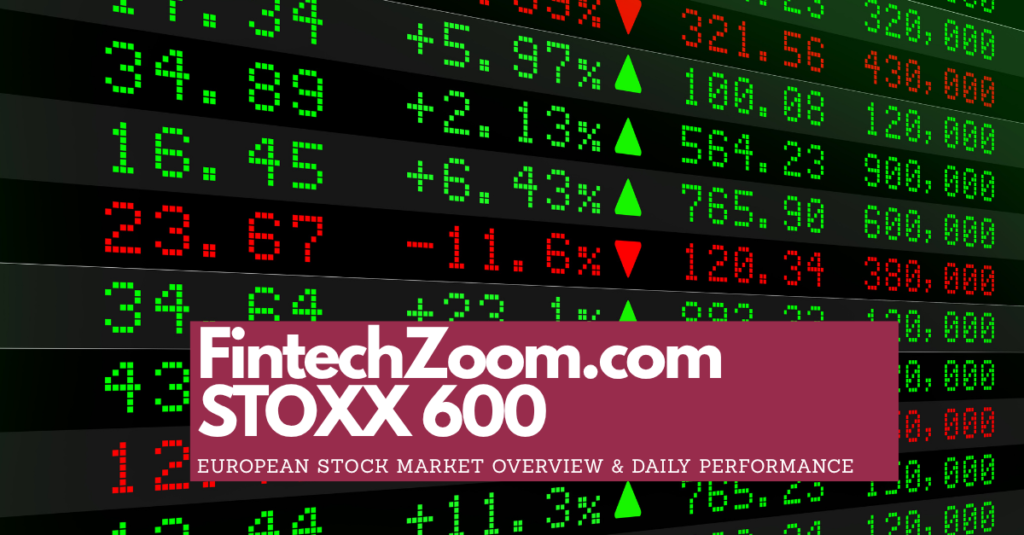The European stock market stands as one of the most diverse and influential financial ecosystems in the world. At the center of it lies the STOXX Europe 600, a benchmark that reflects the performance of 600 leading public companies from across the continent. Through fintechzoom.com stoxx 600, investors gain daily insights into Europe’s equity pulse — from the banking halls of London to the manufacturing hubs of Germany and the luxury houses of France.
- Understanding the STOXX 600 Index
- Index Composition and Methodology
- Historical Context
- Country Representation and Market Influence
- Historical Performance & Long-Term Trends
- Key Sectors Influencing the STOXX 600
- Economic Indicators Impacting the STOXX 600
- How FintechZoom.com Supports STOXX 600 Investors
- Daily Performance Snapshot (November 2025)
- Investment Outlook for 2025–2026
- Investor’s Checklist: How to Approach the STOXX 600
- Conclusion
- FAQs
FintechZoom.com serves as a vital resource for traders and long-term investors alike. The platform delivers real-time market updates, detailed charts, and sector-specific analysis that simplify complex data into actionable knowledge. With Europe’s economic climate evolving rapidly due to shifts in interest rates, inflation, and energy costs, having access to timely, accurate, and visually clear information is essential.
In 2025, the STOXX 600 has become more than just a regional index — it’s a barometer of global investor sentiment. From industrial rebounds to renewable energy investments, the movements of this index often mirror global trends. FintechZoom.com stoxx 600 provides the clarity needed to interpret those trends, guiding investors through Europe’s fast-changing market landscape.
Understanding the STOXX 600 Index

The STOXX Europe 600 brings together 600 major public companies from 17 European countries:
Austria, Belgium, Denmark, Finland, France, Germany, Ireland, Italy, Luxembourg, the Netherlands, Norway, Portugal, Spain, Sweden, Switzerland, the United Kingdom, and Iceland.
This broad inclusion ensures the index reflects nearly 90% of the European equity market by capitalization. Its design makes it one of the most balanced and representative financial indicators in the world.
Index Composition and Methodology

The STOXX 600 uses a free-float market capitalization weighting method, which means larger companies with higher liquidity exert more influence on the index’s performance. Giants such as Nestlé, LVMH, Shell, ASML, Roche, and Unilever consistently shape the index’s movement due to their global reach and financial strength.
The index undergoes quarterly rebalancing to maintain accuracy. Companies may be added or removed based on changes in market value, trading volume, and sector representation. FintechZoom.com provides updates on every rebalance, showing investors how shifts in industries or corporate performances influence the broader index.
Historical Context

Launched in 1998, the STOXX 600 was created to unify Europe’s fragmented markets under a single benchmark. Before its introduction, investors primarily focused on national indices like the FTSE 100 in the UK, DAX 40 in Germany, or CAC 40 in France. The STOXX 600 became a critical bridge for cross-border investment and ETF product development.
FintechZoom.com archives extensive historical performance data, allowing users to trace key events that shaped the index:
- The 2008 global financial crisis and recovery period.
- The 2012 Eurozone debt crisis.
- The pandemic shock of 2020 and its rebound.
- The inflation-driven volatility of 2022.
- The steady growth phase from 2023 through 2025.
This historical visibility helps investors understand cyclical market behavior and make better strategic decisions.
Country Representation and Market Influence

Each participating country plays a unique role:
- Germany – manufacturing, engineering, and automotive industries.
- France – luxury goods, aerospace, and energy.
- United Kingdom – finance, oil, and pharmaceuticals.
- Switzerland – healthcare and consumer staples.
- Netherlands – technology and semiconductors.
- Sweden – industrials and green innovation.
- Italy and Spain – retail and banking.
FintechZoom.com’s regional filters enable users to assess how national performances contribute to daily index shifts, helping identify which economies are currently driving Europe’s momentum.
Historical Performance & Long-Term Trends

Over the past two decades, the STOXX 600 has evolved through multiple economic cycles, reflecting the resilience of European markets. Between 2010 and 2019, the index experienced steady growth, buoyed by monetary stimulus and corporate consolidation. The 2020 pandemic crash briefly erased years of gains, but an aggressive recovery soon followed, supported by vaccine rollouts and fiscal programs.
By 2025, the STOXX 600 reached new highs, driven by innovation in sectors such as healthcare, renewable energy, and digital technology. FintechZoom.com charts reveal that companies adapting early to sustainability and AI trends consistently outperform slower peers.
Key Historical Milestones
- 2008–2009: Financial crisis led to widespread losses; banks and energy sectors suffered most.
- 2012: Eurozone debt fears triggered volatility but paved the way for regulatory reform.
- 2020: Pandemic-induced shock caused a 30% drop in Q1, followed by rapid recovery.
- 2022–2023: Inflation concerns and energy shortages caused renewed uncertainty.
- 2024–2025: AI adoption, green finance, and ECB stabilization policies drove renewed investor optimism.
FintechZoom.com’s interactive timeline showcases these transitions, enabling readers to correlate policy decisions and geopolitical events with index performance.
Key Sectors Influencing the STOXX 600

The index spans every major sector, offering an excellent snapshot of Europe’s industrial diversity.
Financials
Representing roughly 20% of the index, financial institutions from the UK, France, and Switzerland form its backbone. Key players include HSBC, BNP Paribas, Barclays, and UBS. The post-pandemic period brought digital transformation and stronger capital buffers.
Industrials
Companies like Siemens, ABB, and Volvo represent Europe’s industrial strength. Germany and Sweden lead the sector, with investments in robotics and clean energy driving future growth.
Energy
The energy component — including Shell, BP, and Equinor — plays a vital role, especially as Europe transitions toward renewables. FintechZoom.com reports that oil volatility and green policies make this one of the most closely watched sectors.
Healthcare
Switzerland and Denmark dominate here, led by Roche, Novartis, and Novo Nordisk. Post-pandemic, healthcare’s share in the STOXX 600 rose sharply due to innovation in biotech and preventive medicine.
Luxury & Consumer Goods
France’s LVMH, Kering, and L’Oréal, along with Switzerland’s Nestlé, represent global consumer confidence. FintechZoom.com notes that these firms often outperform during economic recoveries as demand for premium brands rebounds.
Technology
Tech giants like ASML and SAP are spearheading Europe’s move toward digital infrastructure and AI adoption. The Netherlands and Germany dominate this space, positioning the region as a key innovation hub.
Economic Indicators Impacting the STOXX 600

The STOXX 600 reacts swiftly to macroeconomic shifts. FintechZoom.com tracks the following key indicators daily:
- ECB Monetary Policy: Interest rate decisions directly influence banking valuations and borrowing costs.
- Inflation Data: Higher consumer prices pressure margins, while lower inflation supports spending.
- Unemployment Rates: Reflect overall demand and confidence in the economy.
- Currency Movements: A weaker euro often boosts exporters; a stronger euro benefits importers.
- Energy Prices: Volatility in oil and gas directly impacts industrial and transportation stocks.
FintechZoom.com’s economy dashboard visualizes how these indicators correspond with market sentiment, helping investors adjust positions with confidence.
How FintechZoom.com Supports STOXX 600 Investors

FintechZoom.com empowers investors through a blend of real-time analytics and educational tools.
1. Real-Time Market Data
Users can access up-to-the-minute price updates, sector leaders, and trading volume. The FintechZoom.com STOXX 600 section provides live index charts and comparative tools with DAX, FTSE, and CAC indices.
2. Sector Insights and Reports
Detailed breakdowns help readers track which industries are driving performance. FintechZoom.com’s analysts publish daily recaps summarizing top gainers, laggards, and investor sentiment.
3. Portfolio Tools
Investors can simulate portfolios based on STOXX 600 components, track diversification metrics, and assess performance against benchmarks.
4. Historical and Predictive Charts
FintechZoom.com’s charts integrate long-term data trends with predictive AI modeling, helping users anticipate volatility and sector rotation.
5. Expert Commentary
The site provides ongoing expert analyses on European market movements, offering clarity on factors affecting daily trends.
Daily Performance Snapshot (November 2025)

| Date (2025) | Closing Value (Points) | Daily Change (%) | Top Performing Sector | Market Sentiment |
| January 10 | 487.32 | +0.56 | Technology | Positive |
| February 5 | 495.48 | +1.18 | Financials | Bullish |
| March 12 | 501.60 | +0.78 | Consumer Goods | Optimistic |
| April 22 | 497.85 | -0.42 | Healthcare | Cautious |
| May 16 | 510.10 | +1.26 | Energy | Bullish |
| June 28 | 506.44 | -0.19 | Industrials | Neutral |
| August 14 | 492.72 | -1.35 | Technology | Weak |
| September 30 | 508.33 | +0.97 | Consumer Services | Stable |
| October 18 | 512.86 | +0.72 | Financials | Positive |
| November 8 | 519.24 | +1.28 | Energy | Strong |
Data Source: FintechZoom.com STOXX 600 Market Dashboard (Updated November 2025)
This data reflects consistent resilience despite economic headwinds. FintechZoom.com’s daily monitoring shows that healthcare, industrials, and luxury goods are the key drivers of growth entering 2026.
Investment Outlook for 2025–2026

Analysts expect moderate but stable growth in the STOXX 600 during 2025–2026. Key supporting factors include:
- Expected ECB rate normalization
- Growth in AI-driven industries
- Green transition investments in energy and infrastructure
- Consumer demand recovery across Western Europe
However, challenges such as geopolitical risk, inflation persistence, and uneven recovery between countries remain.
FintechZoom.com’s predictive models indicate potential for a 6–8% annual return if European inflation remains contained and corporate earnings continue rising. The index’s stability makes it attractive for both institutional investors and diversified ETF portfolios.
Investor’s Checklist: How to Approach the STOXX 600

To help both beginners and experienced investors make informed decisions, FintechZoom.com outlines a simple yet strategic checklist for tracking and investing in the STOXX Europe 600.
1. Monitor Daily Movements on FintechZoom.com
Check the FintechZoom.com STOXX 600 dashboard for live price updates, sector performance, and country-specific data. Short-term shifts can reveal sentiment changes or sector rotation trends before they appear in financial news.
2. Review Sector Weightings Regularly
Financials, industrials, and healthcare dominate the index. Keeping an eye on how each sector performs helps investors anticipate overall market direction. FintechZoom.com’s sector filters make this easy to visualize in real time.
3. Track ECB and Economic Data
European Central Bank (ECB) decisions on interest rates, inflation, and quantitative policy directly influence STOXX 600 valuation. Set FintechZoom alerts to stay updated whenever new economic data is released.
4. Diversify Using STOXX 600 ETFs
Consider ETFs that track the STOXX Europe 600 for diversified exposure to 17 European markets. This reduces individual stock risk while capturing broader growth potential.
5. Watch for Earnings Season
Quarterly earnings from companies like Nestlé, ASML, and LVMH often drive short-term volatility. FintechZoom.com’s corporate calendar helps investors prepare ahead of announcements.
6. Analyze Currency Movements
The euro’s strength or weakness affects exporters and importers differently. Monitoring EUR/USD trends through FintechZoom.com helps manage international portfolio risk.
7. Identify Long-Term Growth Themes
Focus on sectors driving Europe’s future: green energy, AI technology, and digital infrastructure. FintechZoom’s editorial insights highlight where institutional capital is flowing.
8. Evaluate Country Exposure
Balance investments across regions — for instance, mixing Germany’s industrials with France’s consumer goods and the UK’s financials — to minimize localized shocks.
9. Follow Global Market Correlations
The STOXX 600 doesn’t move in isolation. Compare its trends with the S&P 500, DAX 40, and FTSE 100 using FintechZoom’s comparison charts to identify broader opportunities.
10. Set a Rebalancing Schedule
Review your STOXX 600-related investments quarterly. Use FintechZoom.com’s portfolio analysis tools to assess performance, risk exposure, and allocation efficiency.
Pro Tip from FintechZoom.com:
Investing in the STOXX 600 is not just about tracking prices — it’s about understanding how Europe’s industries, currencies, and central bank policies interact. Staying informed through data-driven updates gives you a major edge in anticipating market trends before they unfold.
Conclusion
The STOXX Europe 600 stands as one of the most reliable measures of Europe’s economic health — blending companies from 17 nations into a single, powerful indicator. Whether you’re a retail investor exploring ETFs or an institutional fund manager balancing global exposure, understanding this index is crucial to navigating European markets.
FintechZoom.com stoxx 600 offers a complete toolkit for that purpose: live updates, analytical charts, sector comparisons, and professional commentary. Its real-time insight enables investors to follow every shift in Europe’s economic story — from industrial transformation to technological progress.
As 2026 approaches, Europe’s financial landscape continues to evolve. Through FintechZoom.com’s coverage of the STOXX 600, investors can track that evolution confidently, making informed decisions based on clear, data-driven insights.
FAQs
Q: What is fintechzoom.com stoxx 600?
A: It’s FintechZoom.com’s comprehensive coverage of the STOXX Europe 600 — an index tracking 600 major companies across 17 European countries.
Q: Which countries are included in the STOXX 600?
A: The index covers Austria, Belgium, Denmark, Finland, France, Germany, Ireland, Italy, Luxembourg, the Netherlands, Norway, Portugal, Spain, Sweden, Switzerland, the United Kingdom, and Iceland.
Q: Why is the STOXX 600 important for investors?
A: It provides a complete view of Europe’s equity markets, helping investors monitor growth, sector trends, and macroeconomic shifts.
Q: How does FintechZoom.com help STOXX 600 investors?
A: FintechZoom.com offers real-time data, charts, historical analysis, and expert insights that make market movements easier to understand.
Q: What are the top-performing sectors in 2025?
A: Healthcare, luxury goods, and technology have been among the strongest contributors to the STOXX 600’s performance this year.




